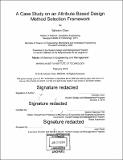| dc.contributor.advisor | Warren Seering. | en_US |
| dc.contributor.author | Chen, Ephraim | en_US |
| dc.contributor.other | Massachusetts Institute of Technology. Integrated Design and Management Program. | en_US |
| dc.date.accessioned | 2018-10-15T20:25:08Z | |
| dc.date.available | 2018-10-15T20:25:08Z | |
| dc.date.copyright | 2018 | en_US |
| dc.date.issued | 2018 | en_US |
| dc.identifier.uri | http://hdl.handle.net/1721.1/118557 | |
| dc.description | Thesis: S.M. in Engineering and Management, Massachusetts Institute of Technology, System Design and Management Program, 2018. | en_US |
| dc.description | Cataloged from PDF version of thesis. | en_US |
| dc.description | Includes bibliographical references (pages 149-152). | en_US |
| dc.description.abstract | This work demonstrates the effectiveness of using the concept of attributes or properties to identify, compare, and select methods for the design of aerospace systems. Growing product development cost trends for these complex systems have been alarming to the aerospace industry. To curb rising development costs by improving the product design actions that drive them, the issue is viewed from a "design system" perspective that distinguishes between the product design process - the set of tasks or problems to solve to produce a design - and the set of problem-solving techniques or methods used to complete the tasks. Support of a structured approach for designers to select their methods would help ensure that methods meeting the specific quality, budget and schedule needs of each unique design situation are utilized in a manner that is transparent to the whole design team. This thesis develops a conceptual framework for method selection decision support that combines a multi-form design process-methodology model with a general collection of attributes for characterizing any method. The model and attribute framework enable the discovery and comparison of alternative design methods relative to a given design task's requirements. The framework was validated by a case study on the early system-level conceptual design phase of a recent industry flight vehicle development program. By employing graphical and matrix modeling techniques, primary research and interviews with members of the industry design team empirically substantiated the overall efficacy of the framework, indicated four particular attributes that are especially important for comparing methods, and revealed six contextual factors that influence the attribute-based characterization of a method. | en_US |
| dc.description.statementofresponsibility | by Ephraim Chen. | en_US |
| dc.format.extent | 152 pages | en_US |
| dc.language.iso | eng | en_US |
| dc.publisher | Massachusetts Institute of Technology | en_US |
| dc.rights | MIT theses are protected by copyright. They may be viewed, downloaded, or printed from this source but further reproduction or distribution in any format is prohibited without written permission. | en_US |
| dc.rights.uri | http://dspace.mit.edu/handle/1721.1/7582 | en_US |
| dc.subject | Engineering and Management Program. | en_US |
| dc.subject | Integrated Design and Management Program. | en_US |
| dc.title | A case study on an attribute-based design method selection framework | en_US |
| dc.type | Thesis | en_US |
| dc.description.degree | S.M. in Engineering and Management | en_US |
| dc.contributor.department | Massachusetts Institute of Technology. Engineering and Management Program | en_US |
| dc.contributor.department | Massachusetts Institute of Technology. Integrated Design and Management Program. | en_US |
| dc.identifier.oclc | 1055204479 | en_US |
